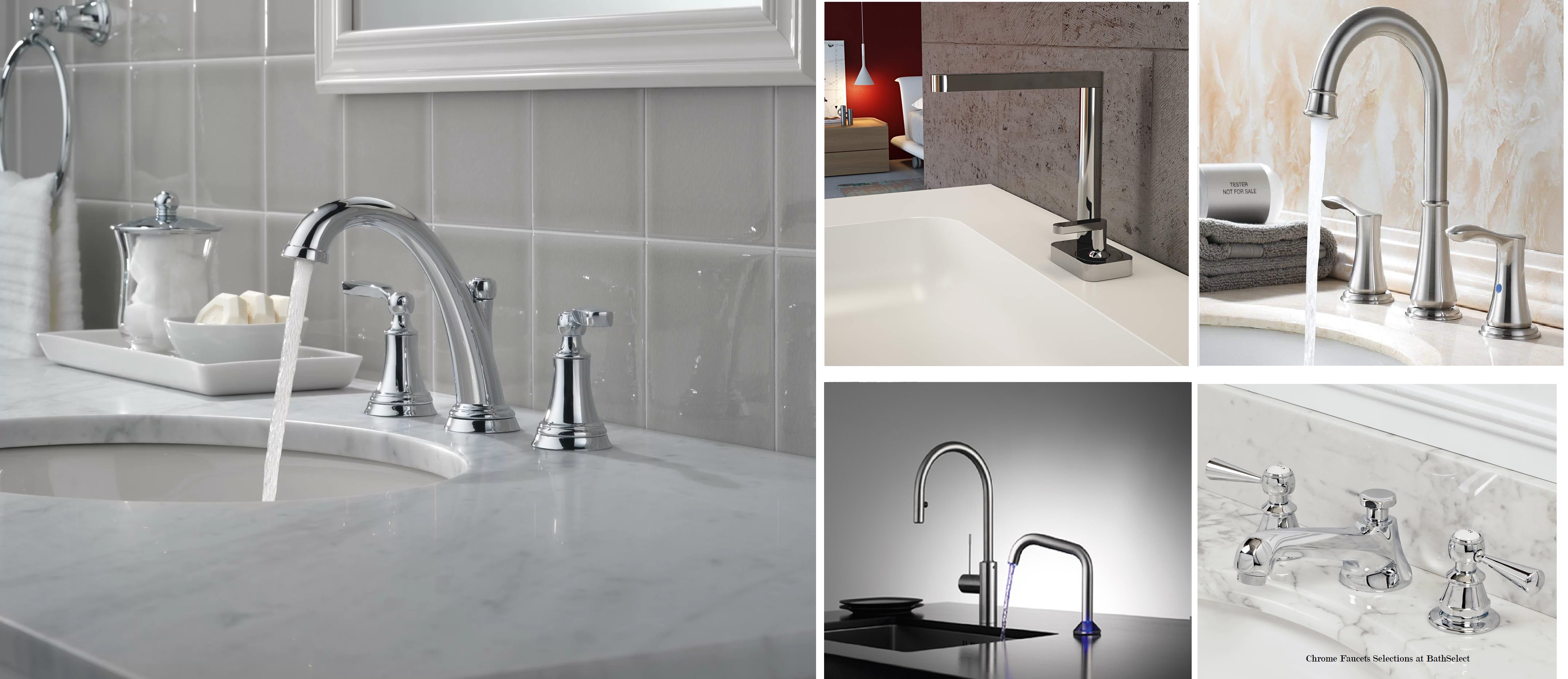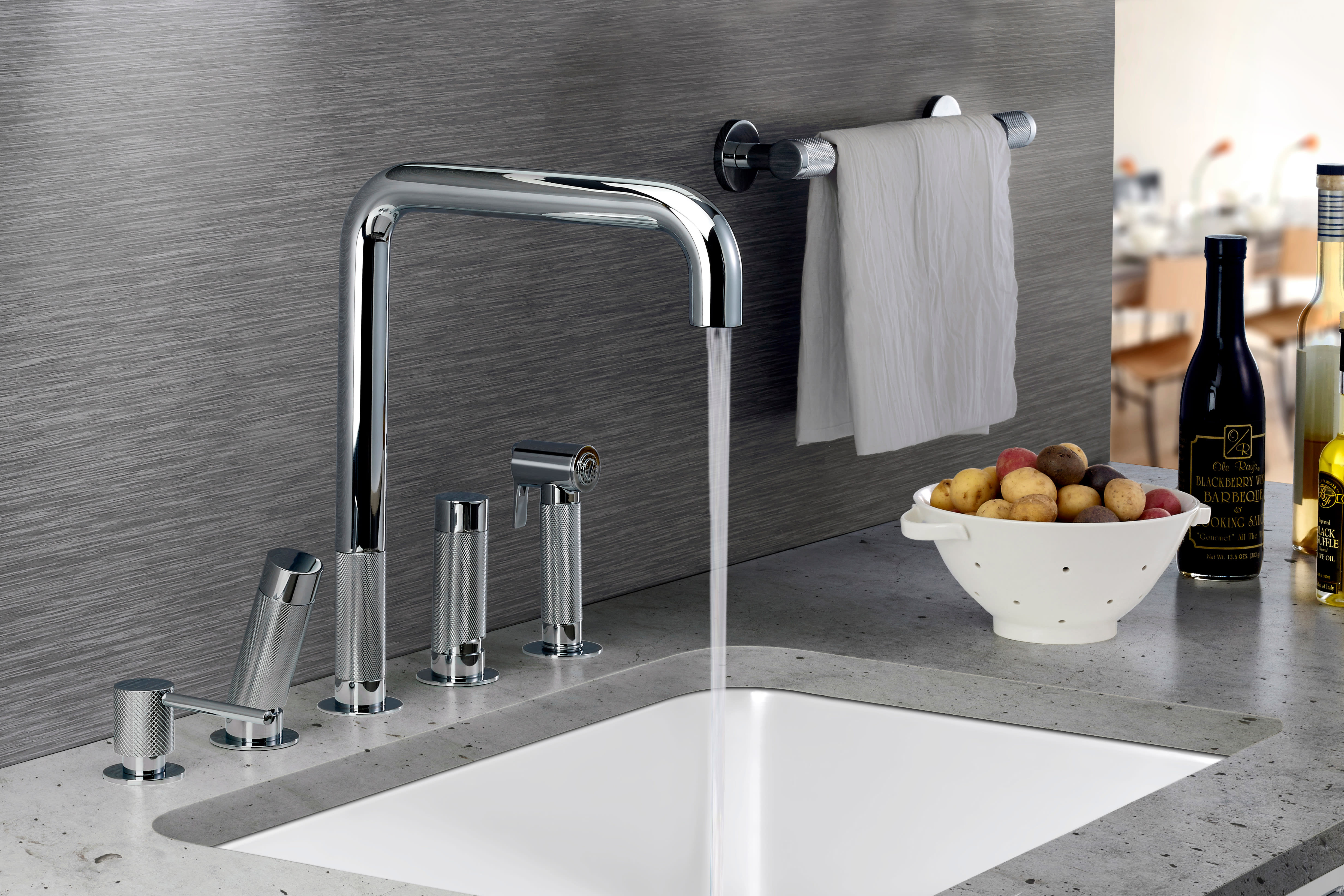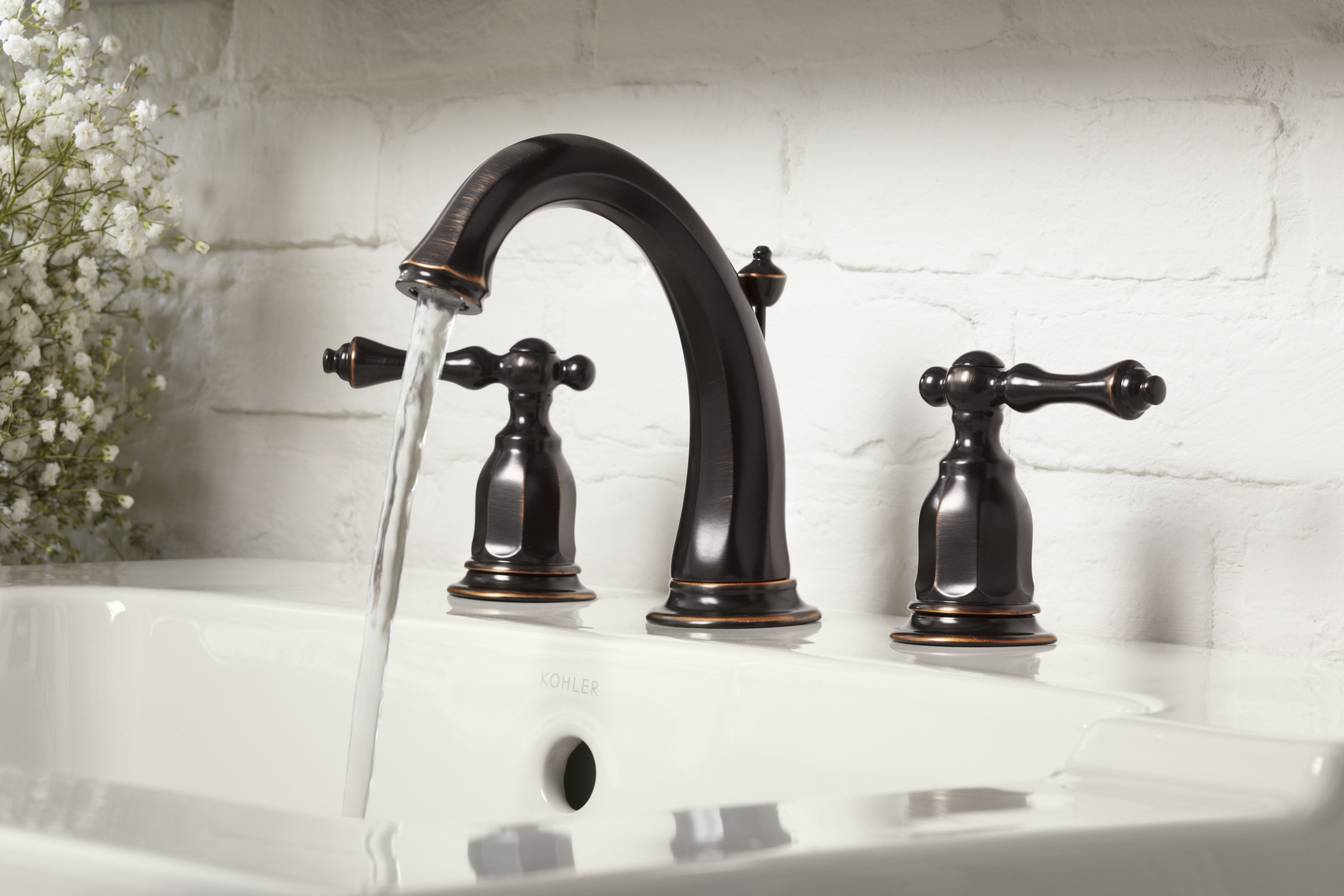Functionality and Design
Choosing the right faucet for your kitchen or bathroom is crucial for both functionality and aesthetics. Kitchen and bathroom faucets serve distinct purposes, and their designs reflect these differences.
Functionality
Kitchen faucets are designed for a variety of tasks, including filling pots and pans, washing dishes, and rinsing produce. Bathroom faucets, on the other hand, are primarily used for washing hands and faces, brushing teeth, and filling bathtubs.
- Kitchen faucets often feature a higher arc spout to accommodate large pots and pans, and some models include pull-down sprayers for added versatility.
- Bathroom faucets typically have shorter, more traditional spouts, and some come with diverter valves to switch between the faucet and showerhead.
Design Elements
Kitchen and bathroom faucets often differ in their design elements, reflecting their intended use.
- Kitchen faucets tend to be more utilitarian in design, with emphasis on functionality. They often feature sleek, modern lines, with chrome or stainless steel finishes being the most common.
- Bathroom faucets are often more decorative, with a wider range of finishes and styles available. From traditional to contemporary, bathroom faucets can complement any bathroom décor.
Common Faucet Styles
There are numerous faucet styles available for both kitchens and bathrooms.
- Kitchen faucets commonly include:
- Single-handle faucets: These faucets have a single lever for controlling both water temperature and flow.
- Double-handle faucets: These faucets feature separate handles for controlling hot and cold water.
- Pull-down spray faucets: These faucets have a sprayer that can be pulled down for added versatility.
- Gooseneck faucets: These faucets feature a curved spout that extends outward, providing ample clearance for large pots and pans.
- Bathroom faucets commonly include:
- Centerset faucets: These faucets feature a single handle mounted in the center of the sink.
- Widespread faucets: These faucets have two handles that are mounted separately on the sink.
- Wall-mounted faucets: These faucets are mounted to the wall, offering a clean and minimalist look.
Water Flow and Pressure Requirements
Kitchen and bathroom faucets have different water flow and pressure requirements.
- Kitchen faucets generally require higher water flow rates to accommodate tasks like filling pots and washing dishes.
- Bathroom faucets typically have lower flow rates, as they are primarily used for washing hands and faces.
Features and Technology: Kitchen Faucet Vs Bathroom Faucet

Modern kitchen and bathroom faucets offer a wide range of features and technological advancements that enhance functionality, convenience, and aesthetics. These innovations cater to various needs and preferences, transforming everyday tasks into more enjoyable experiences.
Faucet Features
Modern faucets boast innovative features that enhance convenience and functionality. Here are some of the most notable:
- Pull-Out Sprayers: These versatile sprayers extend from the faucet, providing a powerful stream for cleaning dishes or rinsing food. Some models offer multiple spray settings, including a gentle aerated stream for delicate tasks and a forceful jet for heavy-duty cleaning.
- Touch-Activated Sensors: Touch-activated faucets utilize sensors that respond to a simple touch, eliminating the need for manual operation. This hands-free functionality is particularly useful in kitchens and bathrooms where hygiene is paramount.
- Temperature Control Mechanisms: Modern faucets offer precise temperature control mechanisms. Some models feature dual handles, allowing separate adjustment of hot and cold water flow. Others employ single-lever designs, providing smooth and effortless temperature regulation.
Faucet Finishes
The finish of a faucet plays a crucial role in its aesthetics and durability. Common faucet finishes include:
- Chrome: A classic and popular choice, chrome offers a sleek and reflective finish that is resistant to scratches and tarnishing. Its durability makes it suitable for high-traffic areas.
- Nickel: Nickel finishes are known for their warm and subtle tones. They are often available in brushed or polished variations, providing a range of aesthetic options. Nickel finishes are generally resistant to corrosion and scratches.
- Brushed Brass: Brushed brass offers a rustic and elegant appearance with a warm, golden hue. This finish is often chosen for its unique texture and ability to complement traditional or modern décor.
Water-Saving Technology
Modern faucets incorporate innovative water-saving technologies to conserve water without compromising performance.
- Aerators: Aerators mix air with water, creating a fuller and more forceful stream while reducing water flow. This technology significantly reduces water consumption without sacrificing functionality.
- Flow Restrictors: Flow restrictors are devices installed within the faucet that limit the amount of water flowing through the spout. They effectively reduce water consumption without noticeably affecting the water pressure.
Comparison of Kitchen and Bathroom Faucet Features
The following table highlights the common features and technology found in both kitchen and bathroom faucets:
| Feature | Kitchen Faucet | Bathroom Faucet |
|---|---|---|
| Pull-Out Sprayer | Common | Less Common |
| Touch-Activated Sensors | Common | Less Common |
| Temperature Control Mechanisms | Dual Handles or Single Lever | Dual Handles or Single Lever |
| Water-Saving Technology | Aerators and Flow Restrictors | Aerators and Flow Restrictors |
Installation and Maintenance

Installing and maintaining a kitchen or bathroom faucet is a straightforward process that can be tackled by most homeowners with basic DIY skills. Understanding the differences in installation and maintenance procedures for each type of faucet can help ensure a smooth and efficient experience.
Installation Process
The installation process for both kitchen and bathroom faucets involves similar steps, but there are some key differences to consider.
- Kitchen Faucets: Kitchen faucets are typically larger and heavier than bathroom faucets, requiring more robust mounting systems. They may also have additional features like pull-out sprayers or soap dispensers, which necessitate additional connections and installation steps.
- Bathroom Faucets: Bathroom faucets are generally smaller and lighter, making them easier to install. They typically have fewer connections and features, simplifying the installation process.
Step-by-Step Guide for Installing a Kitchen Faucet
- Turn off the water supply: Locate the shut-off valves for the hot and cold water lines supplying the sink and turn them off.
- Disconnect the old faucet: Unscrew the old faucet’s mounting nuts and disconnect the water supply lines.
- Install the new faucet’s mounting plate: Position the new faucet’s mounting plate on the sink and secure it with the provided mounting screws.
- Connect the water supply lines: Connect the new faucet’s water supply lines to the shut-off valves, ensuring a tight seal.
- Install the faucet body: Secure the new faucet’s body to the mounting plate with the provided mounting nuts.
- Turn on the water supply: Carefully turn on the water supply valves and check for any leaks.
- Test the faucet: Run water through the faucet to ensure it operates smoothly and without leaks.
Maintenance Checklist
Regular maintenance is essential for keeping both kitchen and bathroom faucets in optimal condition and extending their lifespan.
- Routine Cleaning: Clean the faucet regularly with a soft cloth and mild dish soap to remove dirt and grime. Avoid harsh chemicals or abrasive cleaners, as they can damage the finish.
- Descaling: If hard water is a concern, descale the faucet periodically with a vinegar solution to remove mineral buildup.
- Lubrication: Apply a small amount of silicone lubricant to the faucet’s moving parts, such as the handle and spout, to ensure smooth operation.
- Check for leaks: Regularly inspect the faucet for any leaks or drips. Address any leaks promptly to prevent further damage and water waste.
Troubleshooting Common Faucet Issues
- Leaky Faucet: A leaky faucet can be caused by a worn-out washer, a loose cartridge, or a damaged O-ring. Replacing the worn-out part or tightening the loose component can resolve the issue.
- Dripping Faucet: A dripping faucet can be caused by a worn-out washer, a loose cartridge, or a buildup of mineral deposits. Replacing the worn-out part, tightening the loose component, or cleaning the mineral deposits can fix the issue.
- Clogged Aerator: A clogged aerator can cause reduced water flow or a sputtering sound. Remove the aerator and clean it with a small brush or a toothpick.
- Stuck Handle: A stuck handle can be caused by a buildup of mineral deposits or a worn-out O-ring. Cleaning the mineral deposits or replacing the O-ring can resolve the issue.
Choosing the Right Faucet

Choosing the right faucet for your kitchen or bathroom is an important decision, as it impacts both functionality and aesthetics. Consider factors like your sink size, countertop material, personal preferences, and the overall style of your space to ensure you select a faucet that meets your needs.
Kitchen Faucet Considerations, Kitchen faucet vs bathroom faucet
When choosing a kitchen faucet, consider the following factors:
- Sink Size: A large sink may require a taller faucet with a wider reach, while a smaller sink may be better suited for a compact faucet.
- Countertop Material: Some countertops are more prone to scratches than others. Choose a faucet with a finish that is resistant to scratches and stains.
- Personal Preferences: Consider your preferred style, functionality, and budget. Do you prefer a single-handle or double-handle faucet? Do you need a pull-down sprayer? What type of finish do you prefer?
Bathroom Faucet Considerations
Choosing the right bathroom faucet involves a similar process, focusing on design, functionality, and practicality:
- Bathroom Style: Consider the overall style of your bathroom and choose a faucet that complements it. For example, a modern bathroom might call for a sleek, minimalist faucet, while a traditional bathroom might be better suited for a more ornate design.
- Functionality: Think about the type of functionality you need. Do you need a separate shower head? Do you want a faucet with a built-in soap dispenser?
- Finishes: Bathroom faucets come in a variety of finishes, such as chrome, nickel, brushed nickel, and oil-rubbed bronze. Choose a finish that complements the other fixtures in your bathroom.
Faucet Styles and Finishes
Faucet styles and finishes can significantly impact the overall look and feel of your kitchen or bathroom. Consider these factors:
- Traditional: These faucets typically have a more ornate design and are often made of brass or bronze. They are a good choice for traditional kitchens and bathrooms.
- Modern: Modern faucets are characterized by their sleek, minimalist designs. They are often made of stainless steel or chrome.
- Contemporary: Contemporary faucets fall somewhere between traditional and modern styles. They often feature geometric shapes and clean lines.
- Finishes: Chrome is a popular choice for faucets due to its durability and shine. Nickel is another popular choice, and it comes in a variety of finishes, such as brushed nickel and oil-rubbed bronze.
Choosing the Right Faucet: A Flowchart
1. What is the intended use of the faucet?
* Kitchen: Proceed to Step 2
* Bathroom: Proceed to Step 4
2. What is the size of your sink?
* Large: Consider a taller faucet with a wider reach.
* Small: Consider a compact faucet.
3. What is your preferred style and functionality?
* Traditional: Choose a faucet with an ornate design.
* Modern: Choose a faucet with a sleek, minimalist design.
* Do you need a pull-down sprayer?
* Do you have any other specific features in mind?
4. What is the overall style of your bathroom?
* Traditional: Choose a faucet with an ornate design.
* Modern: Choose a faucet with a sleek, minimalist design.
* Contemporary: Choose a faucet with a geometric shape and clean lines.
5. What is your preferred finish?
* Chrome: Durable and shiny.
* Nickel: Available in a variety of finishes.
* Oil-rubbed bronze: Adds a rustic touch.
6. Choose the faucet that best meets your needs.
Trends and Innovations

The world of kitchen and bathroom faucets is constantly evolving, driven by a desire for enhanced functionality, sleek aesthetics, and sustainable practices. From smart features that offer hands-free convenience to eco-friendly technologies that conserve water, these innovations are transforming how we interact with these essential fixtures.
Smart Faucets: A Glimpse into the Future
Smart faucets are revolutionizing the way we use water in both kitchens and bathrooms. These technologically advanced fixtures offer a range of features that enhance convenience, efficiency, and hygiene.
The advantages of using smart faucets are numerous:
* Hands-free Operation: Smart faucets utilize motion sensors or voice control to activate water flow, allowing for hands-free operation. This is particularly beneficial in kitchens, where messy hands can be a common occurrence, and in bathrooms, where maintaining hygiene is paramount.
* Precise Temperature Control: Smart faucets often feature digital displays that allow users to precisely control water temperature. This eliminates the guesswork associated with traditional faucets and ensures a comfortable water experience.
* Water Conservation: Some smart faucets incorporate flow restrictors or automatic shut-off mechanisms to minimize water usage. These features can significantly reduce water consumption and lower utility bills.
* Enhanced Hygiene: The hands-free operation of smart faucets minimizes contact with the faucet itself, reducing the spread of germs and bacteria. This is particularly important in high-traffic areas like kitchens and bathrooms.
However, there are also some potential disadvantages to consider:
* Cost: Smart faucets tend to be more expensive than traditional faucets due to their advanced technology and features.
* Technical Issues: Like any electronic device, smart faucets can experience technical glitches or require software updates. This could lead to temporary disruptions in functionality.
* Dependence on Power: Most smart faucets require a power source, either through batteries or electrical wiring. This could be a concern in areas with limited power availability.
Sustainable Materials and Manufacturing Practices
The future of faucet design is increasingly focused on sustainability. Manufacturers are embracing eco-friendly materials and manufacturing practices to minimize environmental impact.
* Recycled Materials: Some faucet manufacturers are incorporating recycled materials, such as recycled brass and stainless steel, into their products. This reduces the demand for virgin materials and minimizes waste.
* Water-Saving Technologies: Innovations like aerators, flow restrictors, and automatic shut-off mechanisms are becoming standard features in faucets, helping to conserve water and reduce energy consumption.
* Low-VOC Finishes: Faucet finishes are often coated with volatile organic compounds (VOCs), which can contribute to indoor air pollution. Manufacturers are increasingly adopting low-VOC or VOC-free finishes to create healthier living environments.
Innovative Features Transforming Faucet Design
Beyond smart features and sustainable materials, a number of innovative features are changing the way people interact with kitchen and bathroom faucets:
* Pull-Down Sprayers: Pull-down sprayers offer increased flexibility and reach, making it easier to fill pots, clean dishes, and wash delicate items.
* Magnetic Docking: Magnetic docking systems ensure that the sprayer head stays securely in place when not in use, preventing it from swinging freely.
* Touchless Technology: Touchless faucets respond to a simple hand gesture, eliminating the need for physical contact and promoting hygiene.
* LED Lighting: Some faucets incorporate LED lighting to illuminate the sink area, providing better visibility and enhancing the overall aesthetic.
* Smart Integration: Smart faucets can be integrated with home automation systems, allowing for voice control, remote monitoring, and other advanced features.
These innovations are transforming the functionality, aesthetics, and sustainability of kitchen and bathroom faucets, creating a more convenient, efficient, and eco-conscious experience for users.
